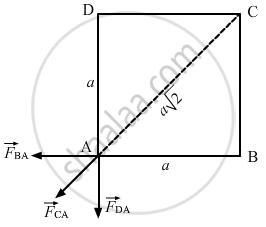Advertisements
Advertisements
प्रश्न
Four equal charges of 2.0 × 10−6 C each are fixed at the four corners of a square of side 5 cm. Find the Coulomb's force experienced by one of the charges due to the other three.
उत्तर
Given,
Magnitude of the charges,
\[q = 2 \times {10}^{- 6} C\] Side of the square,
\[a = 5 \text{ cm = 0 . 05 m }\]
By Coulomb's Law, force,
\[F = \frac{1}{4\pi \epsilon_0}\frac{q_1 q_2}{r^2}\]

So, force on the charge at A due to the charge at B,
\[\vec{F}_{BA} = \frac{9 \times {10}^9 \times \left( 2 \times {10}^{- 6} \right)^2}{\left( 0 . 05 \right)^2} \]
\[ = \frac{9 \times {10}^9 \times 4 \times {10}^{- 12}}{25 \times {10}^{- 4}}\]
\[ = 14 . 4 N\]
Force on the charge at A due to the charge at C,
\[\vec{F}_{CA} = \frac{9 \times {10}^9 \times \left( 2 \times {10}^{- 6} \right)^2}{\left( \sqrt{2} \times 0 . 05 \right)^2}\]
\[ = \frac{9 \times {10}^9 \times 4 \times {10}^{- 12}}{25 \times 2 \times {10}^{- 4}}\]
\[ = 7 . 2 N\]
Force on the charge at A due to the charge at D,
\[\vec{F}_{DA} = \vec{F}_{BA}\]
The resultant force at A, F'= \[\vec{F}_{BA} + \vec{F}_{CA} + \vec{F}_{DA}\]
The resultant force of \[\vec{F}_{DA} \text{ and } \vec{F}_{BA}\] will be \[\sqrt{2} F_{BA}\] in the direction of \[\vec{F}_{CA}\] . Hence, the resultant force,
\[F' = 14 . 4\sqrt{2} + 7 . 2\]
\[ = 27 . 56 N\]
APPEARS IN
संबंधित प्रश्न
The electrostatic force on a small sphere of charge 0.4 μC due to another small sphere of charge − 0.8 μC in air is 0.2 N.
- What is the distance between the two spheres?
- What is the force on the second sphere due to the first?
- Two insulated charged copper spheres A and B have their centers separated by a distance of 50 cm. What is the mutual force of electrostatic repulsion if the charge on each is 6.5 × 10−7 C? The radii of A and B are negligible compared to the distance of separation.
- What is the force of repulsion if each sphere is charged double the above amount, and the distance between them is halved?
A particle of mass m and charge (−q) enters the region between the two charged plates initially moving along x-axis with speed vx (like particle 1 in the fig.). The length of plate is L and an uniform electric field E is maintained between the plates. Show that the vertical deflection of the particle at the far edge of the plate is qEL2/(2m`"v"_"x"^2`).

Plot a graph showing the variation of coulomb force (F) versus ,`(1/r^2)` where r is the distance between the two charges of each pair of charges: (1 μC, 2 μC) and (2 μC, − 3 μC). Interpret the graphs obtained.
Find the dimensional formula of ε0.
A charge of 1.0 C is placed at the top of your college building and another equal charge at the top of your house. Take the separation between the two charges to be 2.0 km. Find the force exerted by the charges on each other. How many times your weight is this force?
Two charges 2.0 × 10−6 C and 1.0 × 10−6 C are placed at a separation of 10 cm. Where should a third charge be placed, such that it experiences no net force due to these charges?
Suppose all the electrons of 100 g water are lumped together to form a negatively-charged particle and all the nuclei are lumped together to form a positively-charged particle. If these two particles are placed 10.0 cm away from each other, find the force of attraction between them. Compare it with your weight.
Suppose an attractive nuclear force acts between two protons which may be written as F=Ce−kr/r2. Write down the dimensional formulae and appropriate SI units of C and k.
Two identical pith balls are charged by rubbing one against the other. They are suspended from a horizontal rod through two strings of length 20 cm each, the separation between the suspension points being 5 cm. In equilibrium, the separation between the balls is 3 cm. Find the mass of each ball and the tension in the strings. The charge on each ball has a magnitude 2.0 × 10−8 C.
Two small spheres, each with a mass of 20 g, are suspended from a common point by two insulating strings of length 40 cm each. The spheres are identically charged and the separation between the balls at equilibrium is found to be 4 cm. Find the charge on each sphere.
Two particles A and B, each carrying a charge Q, are held fixed with a separation dbetween them. A particle C of mass m and charge q is kept at the middle point of the line AB. If it is displaced through a distance x perpendicular to AB, what would be the electric force experienced by it?
Repeat the previous problem if the particle C is displaced through a distance x along the line AB.
Three identical charges, each with a value of 1.0 × 10−8 C, are placed at the corners of an equilateral triangle of side 20 cm. Find the electric field and potential at the centre of the triangle.
Define a unit charge.
Solve numerical example.
Three equal charges of 10×10-8 C respectively, each located at the corners of a right triangle whose sides are 15 cm, 20 cm, and 25cm respectively. Find the force exerted on the charge located at the 90° angle.
Write down Coulomb’s law in vector form and mention what each term represents.
Which of the following statements about nuclear forces is not true?
